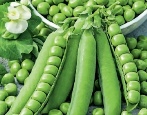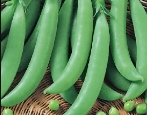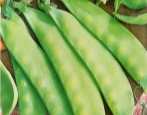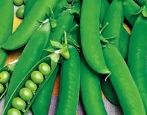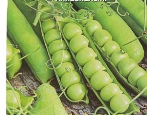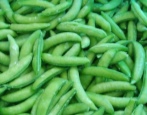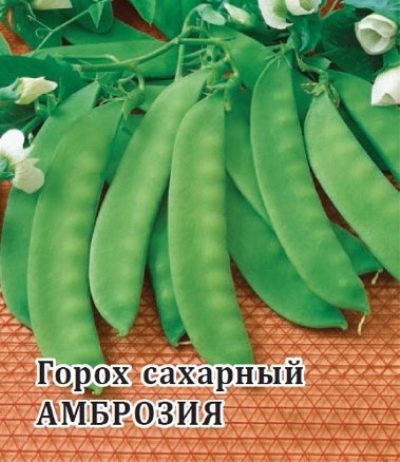
- Name synonyms: Ambrozia
- Year of approval: 2009
- Ripening terms: early maturing
- View: sugar
- The period from germination to technical ripeness: 45-55 days
- Stem length, cm: 50-70
- Sheet: regular, medium, green, waxy
- Stipules: medium, light mottling
- Flowers: medium to large, white
- Parchment layer: absent
Ambrosia tops the ratings of the best pea varieties. This variety is originally from Germany, but is well adapted for cultivation in Russia.
Description of the variety
Ambrosia is a sugar variety without a dense inner parchment layer in the valves. These varieties can be eaten whole. The bush of the plant is medium, does not tend to grow up to 2.5 meters, like some other plants, so it can do without support. Included in the State Register of Breeding Achievements of Russia in 2009. Originators: Agrofirm "Poisk" and LLC "Avista".
Characterization of the appearance of plants, beans and seeds
The bush is not tall, 50-70 cm, sometimes the stems can grow up to 90 cm. The stems are curly, hollow inside. The leaves are feathery, light gray-green in color, matte. The flowers are white, delicate.
Pods up to 10 cm long, slightly curved, contain 7-8 peas, each reaching 8-9 mm in diameter. At the stage of technical ripeness, the valves and peas are bright green, when fully ripe, they coarsen: the peas become slightly larger, turn yellow and slightly wrinkle. There is no parchment layer in the beans. The leaves are juicy, tasty and crispy.
Purpose and taste
The taste is sweet, full-bodied. The peas are distinguished by an excellent structure - milky-tender, juicy and fleshy. The variety is universal. Peas are consumed fresh, added to any dishes as needed, canned and frozen.
Ripening terms
The variety is early ripe, mass production of beans in technical ripeness begins in a month and a half, or 45-55 days after the emergence of mass shoots. To full, biological maturity, you need another 10 days.
Yield
At the stage of technical ripeness, an average of 500-600 grams of peas are removed from 1 sq. m. Harvesting is usually carried out at the stage of technical ripeness. At the stage of biological ripeness, peas are harvested for seeds. Harvesting for sowing in April-May falls on July-August.
Growing and caring
Sowing seeds - from late April to early May. The Ambrosia variety is universal, it is recommended for cultivation in all regions of Russia, from the North Caucasus to the Far East, so the sowing time can vary greatly.
South of Russia, Krasnodar, Kuban: March - early April.
Middle lane, Moscow region: late April - early May.
Leningrad Region, northwest: early to mid-May.
Siberia, Urals, Far East: early May.
Peas can withstand frosts down to -6 ° C, so you can focus on earlier sowing dates than for most vegetable crops. The soil temperature should be at + 5 ° C at a depth of 5 cm.
Sowing pattern: 15 cm between plants, 30 cm between rows. Can be planted in rows or ribbons (several rows close to each other every 40 cm).
Choose a sunny place for planting. Pea seeds for planting are pre-soaked. They are planted in the soil when the peas give white sprouts. They are deepened by 2-3 cm, no more. You can plant peas a little deeper in loose soil. Only planted peas are watered so that the stream of water does not wash the peas into the depths. It is best to plant immediately after rainfall or wet the soil well before planting. And after planting - just mulch with dry humus, straw or dry grass.
The sprouts will appear in 7-10 days. If the peas have not been pre-soaked, after 10-14 days. Watering is the main article of crop care.Peas Ambrosia is resistant to droughts, but it is necessary to water once a week at least in dry summer. Water for irrigation should not be icy. The best option is a little standing in the sun. On average, they are guided by the weather and soil conditions. If it's dry, it's time to water. Particular attention is paid to the plant when the ovaries appear. It works best by sprinkler irrigation rather than spray irrigation. Consumption rate - 20 liters of water per 1 sq. m.
During the period of fruit formation, potash dressings will be useful - this affects the sweetness and taste of the peas. Ash infusion is a good source of potassium. A glass of ash is poured with 10 liters of hot water. Hold for a day, then filter. The resulting infusion is watered only on wet soil. 1 liter of infusion is enough for 1 plant.
The stems of the variety are quite strong for peas, but support will not be superfluous. Peas are often planted between two supports to prevent fragile stems from collapsing in both directions under the influence of the wind. Ambrosia peas are not too tall, you can get by with a string stretched along one side.
To collect fresh peas all season, seeds are sown 1 time every 10 days from early May to early July.

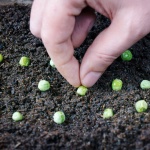
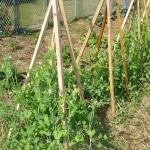

Soil requirements
The soil should be loose, nutritious, airy. On dense, poorly drained soil, where moisture stagnates, peas grow poorly and bear little fruit. The best soils are loam or sand. Fertilizers are applied in the fall: rotted manure, wood ash, humus, compost. Fresh manure should not be applied under the peas. In the spring, when digging, you can add a little urea to the soil. Best predecessors: potatoes, pumpkins, cucumbers.
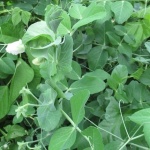
Disease and pest resistance
The variety is resistant to anthracnose. Immunity is high, peas rarely get sick. With good care, the leaves are always fresh, no pests are visible. In unsuitable conditions, the plant can be affected by pests that are very fond of the juicy foliage and stems of this culture. The most dangerous are leafworm (pea moth), aphids, pea thrips, gall midge, weevils and weevils. It is better to spray the plants with a solution of laundry soap in advance. In the early stages, it is easier to defeat the pest. Other preventive measures:
timely autumn cleaning of the site;
sowing at the optimum time;
selection of early maturing varieties, which include Ambrosia peas;
framing beds with white mustard peas.
Spraying with infusion on tomato tops is useful. Unnecessary stepchildren from healthy bushes will do. Half a bucket of greens is poured with a bucket of water and insisted for 2 days.
In the southern regions, peas suffer the most from caryopses. The pest hibernates in storehouses of vegetables and grain, under the bark of trees, in the soil.
From the pea moth, the already affected plants are sprayed with a decoction of herbs: a glass of chopped wormwood herb, half a glass of chopped tansy and 2 cups of finely chopped fruits of hot peppers are placed in 10 liters of water.The mixture is boiled for 1 hour, then allowed to cool and filtered. The affected pea bushes are sprayed with a solution 2 times a week.

Review overview
The variety lives up to its name - it is, indeed, "food of the gods." None of the reviews criticize the taste. The peas are really very sweet, the young pods are tasty in general. Juicy, tender, melt in your mouth with sweetness. The harvest simply does not live up to conservation. If the family has children, then the variety is required for planting. Keeps everything promised. The care is also impeccable. The stems are strong, the plant is unpretentious, active. It can hurt and suffer from pests, but no more than any other variety, and with good care, this is insignificant. Recommended for anyone looking for a versatile sugar pea variety.
